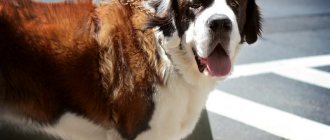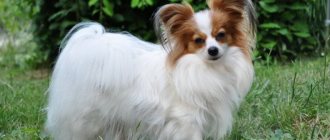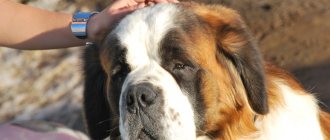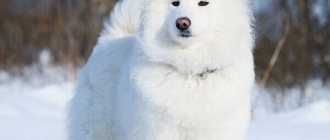Let's get acquainted with one of the largest dog breeds - the St. Bernard. Let's talk about the growth and development of puppies, and figure out how much a St. Bernard weighs at different periods of life. The most interesting indicators are observed during the active growth of puppies from a month to a year. The most active period of growth for a puppy at the withers is from 1 to 7 months, then the dog begins to gain size and weight, which in turn slows down its height growth slightly. A representative of the Saint Bernard breed gains its final height and weight by the age of 2.5 – 3 years.
The article shows the height and weight indicators that were obtained by me in the process of breeding St. Bernards!
Breed traits
Breed traits (on a 5-point scale)
| Saint Bernard | |||
| Activity | in the house | 1.9 | |
| on the street | 3.1 | ||
| Obedience | training | 3.9 | |
| strangers | 4.2 | ||
| Domination | in family | 1.6 | |
| over dogs | 2.1 | ||
| Defending your territory | from people | 2.5 | |
| from dogs | 2.9 | ||
| Sociability | in family | 4.8 | |
| with strangers | 4.1 | ||
| with dogs | 3.3 | ||
| Concentration | in family | 1 | |
| in front of strangers | 1.5 | ||
| with dogs | 2.3 | ||
| Aggressiveness | in family | 1 | |
| to strangers | 1.4 | ||
| to the dogs | 1.7 | ||
| to cats | 1.5 | ||
| Family behavior | calmness | 4.1 | |
| demand for affection | 4.4 | ||
| excitability | 3 | ||
| playfulness | 3.5 | ||
| excessive barking | 1.7 | ||
| behavioral breakdowns | 1.9 | ||
| Tolerance for children | up to 4 years | 4.3 | |
| over 4 years old | 4.4 | ||
| Institutional use | watchman | 3.4 | |
| bodyguard | 1.7 | ||
This breed is often compared to the following dog breeds: Newfoundland, Caucasian Shepherd, German Shepherd, Labrador Retriever, Leonberger.
The photo shows what St. Bernards look like:
Health
The body of giant dogs experiences severe stress from early childhood, so a life expectancy of 8–10 years is considered the norm for St. Bernard. In addition, the dimensions and specific structure are a help for a tendency to a number of breed diseases:
- Skin – pyoderma (pustular dermatitis), eczema, dermatitis.
- Eye – eversion and entropion of the eyelids, adenoma of the third eyelid, cataract.
- Musculoskeletal system – dysplasia of the elbow and hip joints, congenital dislocation and subluxation of the patella, rupture of the cruciate (patella) ligament.
- Cardiovascular system – cardiomyopathy.
- Neurological – epilepsy, congenital deafness.
- Oncological – osteosarcoma (bone cancer), lymphosarcoma (cancer of the lymphatic system).
Important! Representatives of the breed are prone to overheating, both in hot and hot-humid weather.
General characteristics of the St. Bernard breed
The Saint Bernard is a huge dog, but is often kept as a companion. This is due to its unique character. He is balanced, calm, affectionate, good-natured and disciplined. He strives to serve his owner, loves children and gets along well with other pets.
Such features are explained by the history of the origin of the breed. She was bred specifically to help humans. These dogs can carry loads, search for lost people, and sense avalanches. They are hardy, serious, smart and well oriented in space.
Saint Bernards are the best rescue dogs, adapted to work in the mountains. Over the entire existence of the breed, they pulled out several thousand people from under the snow. For this, the breed was included in the Guinness Book of Records three times. And a monument was erected to the most famous St. Bernard, the dog Barry.
Thanks to their patience, desire to save people and unique instincts, representatives of this breed become excellent guide dogs and are used in canistherapy. With proper training, they can also become a guard dog or just a companion.
More photos of representatives of the St. Bernard breed:
| Options | Characteristic |
| breed name | Saint Bernard |
| group of breeds according to the ICF classification | Pinschers and Schnauzers, Molosser section |
| country of origin | Switzerland |
| time of origin | 17th century |
| application | rescuer, service dog, companion |
| peculiarities | slow, good-natured, smart, obedient |
| height | males 70-90 cm, females 65-80 cm |
| weight | males from 60 kg, females from 50 kg |
| life expectancy | 9-11 years |
| aggressiveness | not aggressive at all |
| activity | low, rather slow |
| attitude towards a person | friendly, loyal, patient, loves children |
| intelligence | smart, obedient, easy to train |
| health | weak |
| care | sheds a lot, eats a lot |
pros
Saint Bernards have been around humans for a long time. This is one of the most popular large breeds. This is explained by many advantages:
- soft balanced character;
- these dogs are good-natured and affectionate;
- have good security qualities;
- can be kept outside, tolerates cold well;
- love children, are patient with them, can be a nanny;
- peaceful, gets along with other pets;
- hardy, unpretentious;
- are easy to train;
- They don't bark for no reason.
Minuses
The large size of the St. Bernard creates some problems in its maintenance. He needs free space in the house and a lot of food. This dog also has the following disadvantages:
- prone to drooling;
- sheds heavily;
- has poor health;
- can be stubborn and lazy;
- It does not have protective qualities, since it cannot bite a person.
The video complements the characteristics of these dogs:
Video: St. Bernard is a dog with whom you need to speak as an equal
Video: All about the St. Bernard dog breed
Video: St. Bernard everything about the breed. Interesting Facts.
Movements
The movements are smooth and relaxed, while the back remains almost motionless. A good drive of the hindquarters is noticeable. The front and hind limbs move in one line, the tracks of the hind paws are superimposed or imprinted on the front of the front paws. At the show the dog must trot. In dogs with a displaced center of gravity, lateral rolling is observed when moving.
Any deviation from the above provisions of the St. Bernard breed standard should be considered a fault, and the seriousness with which the fault should be assessed should be proportionate to the degree of its severity and its effect on the health and welfare of the dog.
History of the origin of St. Bernards
The history of the breed begins in the 11th century. At that time, in the Swiss Alps, the monk Bernard founded a monastery that served as a shelter for travelers. It was located in the mountains at an altitude of 2500 meters. This dangerous pass was called Saint Bernard. It was difficult to pass and travelers were often caught in avalanches. The monks used large dogs to search for lost people in the snow. They found a person, dug him up, and warmed him with their bodies.
Such dogs became especially popular by the 17th century. Large, hardy animals with thick skins and a sensitive sense of smell helped the monks transport cargo and warned about avalanches. It is currently unknown what breeds they came from. Researchers believe that the ancestors of the St. Bernard were Tibetan Great Danes or Mastiffs, which were brought to Europe from Asia. They were crossed with local mountain dogs. The breed was then bred at the monastery of St. Bernard, which is why it received its name.
At that time, St. Bernards were different from modern ones. They were more mobile and not as large. One of the dogs, named Barry, became popular because he saved more than 40 people. Now in France there is a monument to this dog, several films have been made. And in the monastery, where St. Bernards continue to be bred, one puppy in each litter is called Barry.
At the beginning of the 19th century, dogs in the monastery began to die from an unknown infection. To save them from extinction, they began to crossbreed with Newfoundlands. This is how the long-haired variety of St. Bernard appeared. But it was not suitable for rescue work in the mountains, so selection was stopped. These dogs became popular in the plains. The monastery still used short-haired individuals.
By the end of the 19th century, Saint Bernards were officially recognized as a separate breed. Clubs began to be created, and a standard was approved. In Russia, these dogs began to be bred after the Great Patriotic War. But they were not valued because of their peaceful nature. The breed became popular only towards the end of the 20th century, after the release of the film “Beethoven”.
Soviet dog handlers in the 50s of the 20th century crossed these dogs with hounds and Caucasian shepherd dogs to enhance their guarding qualities. So, based on the St. Bernard, the Moscow watchdog appeared. She looks almost the same, only a little smaller in height, her muzzle is narrower, there are no jowls. The Moscow watchdog also differs in character: it is more aggressive, stubborn, agile and prone to dominance.
Mating
Such large dogs are bred when they reach the age of two, not earlier. These are quite late dogs, and at one and a half years old they are a playful 70 kilogram puppy.
To avoid health problems, you need to wait until the bones are fully formed. Otherwise, the mother’s sagging back and problems with childbirth cannot be avoided. Difficulties with the health of the offspring cannot be ruled out.
Bitches ovulate approximately 10–14 days after the onset of estrus. During this period, an appointment is made with the male dog. These data are approximate and may vary depending on the characteristics of the organism.
Read a detailed article on the topic: “Everything you need to know about breeding dogs: appropriate age, what to do if it doesn’t work out, rules and tips.”
Today, veterinary clinics can take an analysis to determine whether a female dog is ready for breeding. The male is ready to breed all year round.
Appearance of St. Bernard dogs
Saint Bernards are large, massive animals. A distinctive feature of its appearance is its large head with drooping lips and a melancholic look, which gives the dog a slightly sad expression. The physique is massive, the height of an adult St. Bernard at the withers can reach 90 cm. Bitches are less tall and not so powerful. The average weight of a St. Bernard is 50-70 kg, but some individuals are heavier - weighing 100-120 kg.
Photos complement the description of the appearance of representatives of the St. Bernard breed:
Head
The skull is wide, rounded. The brow ridges, the back of the head and the feet are well defined. There is a furrow running down the middle of the forehead. The muzzle is wide and does not taper towards the tip. The bridge of the nose is smooth, the lobe is large, and always black. The jaws are strong, the lips are black, the corners of the mouth are well defined. The upper lip is fleshy, forms a jowl, and covers the lower jaw.
The eyes are dark, deep-set, and medium in size. The eyelids fit tightly, but a slight sagging of the lower eyelid is allowed. The ears are medium size, fleshy, hanging. They are triangular in shape and set wide apart.
Frame
The neck is long, muscular, and has a dewlap at the throat. The physique is powerful, proportional, slightly longer than tall. The withers are well defined, the back is straight, the croup is long. The chest is deep, but not convex, the belly line is slightly tucked. The tail is strong and thick at the base. The length reaches the hock joint. When excited, the dog only lifts it slightly and can roll it into a ring.
Limbs
The limbs are straight, set parallel and wide. The bones are strong, powerful, and the muscles are pronounced. The paws are wide, the toes are tightly pressed. The dog's movements are smooth and free.
More photos to complement the description of the appearance:
Coat and colors
Now the breed has two varieties: long-haired and short-haired. The first one came from crossing with Newfoundlands. Long-haired dogs have long guard hairs that may be slightly wavy. The undercoat is dense and dense. There are feathers on the paws and tail, the head is covered with shorter hair.
Short-haired St. Bernards are more valued as rescue dogs. It is this variety of the breed that is still bred in the monastery of St. Bernard. Although the varieties differ only in the length of their coat. These dogs have a thick undercoat, the guard hair is hard and lies tightly to the body. Longer hair on hind legs and tail.
The main color of the Saint Bernard, recognized by the standard, is white and red. White spots are required on the forehead, chest, paws, tip of the tail and nape. May be present on the back. A black mask on the face is desirable. The shade of dark color can be brown, red, red, brindle.
Photos of dogs show what St. Bernards are like:
St. Bernard's character
The Saint Bernard dog is very smart, obedient and calm. Its purpose is to help people. She is good-natured and completely devoid of aggression. He is kind even to strangers. But in a dangerous situation it will always protect its owner. Although next to such a giant no one would dare to harm him.
This pet is so attached to the owner and members of his family that he is ready to constantly be nearby and take part in all matters. But this dog will not impose himself. An adult St. Bernard has a calm, even melancholic temperament and shows almost no outward emotion. He loves to lie down and walks on the street with dignity and sedateness.
Innate rescue instincts make this dog a good nanny. He loves children, is always patient and gentle with them, and protects them. A striking example of this behavior is the St. Bernard Beethoven from the film of the same name. It is also peaceful towards other animals.
Interesting pictures characterize the behavior of these dogs:
Features of education and training
The Saint Bernard is easy to train, especially at an early age. He tries to please the owner, understands the words. But he doesn’t always follow commands right away. Sometimes this is due to stubbornness, but mostly due to temperamental characteristics, since St. Bernards tend to fall into thoughtfulness.
It is necessary to socialize the puppy on time. From the first days of his arrival in the house, you need to teach him:
- do not chew or throw things around;
- respond adequately to street noise and cars;
- patiently withstand hygiene procedures;
- walk on a leash and muzzle.
Puppies are smart, they need to start training no later than 2 months. Their peculiarity is that St. Bernards grow up quickly and after 2 years are no longer able to learn new things. An ill-mannered dog of this size can cause problems. After all, even in the absence of aggression, he overwhelms with his weight and size, he can knock a person down, and if he runs, it will be impossible to hold him.
This dog understands basic commands quickly and easily masters various skills. You just need to take into account that jumping and intense physical activity are contraindicated for St. Bernard puppies. They can lead to joint diseases.
During training, you need to interest your pet. Reward correct behavior with treats and praise. Hitting or rudely scolding a St. Bernard is unacceptable. He may lose interest in activities.
This video will help you learn how to raise St. Bernards:
Video: St. Bernard puppy OKD, the work of an instructor teaching the owner how to train a dog
Video: How to properly train a St. Bernard!
Video: Saint Bernard features of training and education
Learning ability
Saint Bernards are very smart, and most importantly, their heredity presupposes an intuitive understanding of humans. They are quite disciplined by nature and quickly learn the basic rules of behavior. But you need to start training your dog as early as possible. An adult St. Bernard may simply get bored with monotonous training and become stubborn. Therefore, we will give this dog’s learning ability 3 points on a five-point scale.
Maintenance and care
It is best to keep a St. Bernard in a spacious private house with a plot. Such a giant will feel cramped in a small city apartment. Long-haired representatives of the breed live without problems in an outdoor enclosure; individuals with short hair are best kept indoors in winter. You cannot put a St. Bernard on a chain.
Saint Bernards are quite slow. But an adult dog needs to walk 3-4 hours a day. In summer, it is better to reduce walks; it is advisable for the pet to be in the shade. Due to their thick undercoat, these dogs cannot tolerate heat.
Caring for a St. Bernard is simple; normal hygiene procedures are required: rubbing eyes, ears, brushing teeth and trimming nails. Only because of the peculiarities of the structure of the muzzle is it necessary to wash it after eating.
It is advisable to comb long-haired animals every other day, and daily during shedding. You will need a comb with long, sparse teeth. For short-haired dogs, it is enough to brush them once a week. To do this, you can use a stiff brush or rubber mitt. It is better to trim the hair between the fingers and in the ears.
It is not recommended to bathe these dogs often - 2-3 times a year is enough. It is advisable to do this after shedding to facilitate hair change. After walks, you need to wash your paws; your pet should be taught this procedure from an early age.
The pictures show how to keep a St. Bernard:
Health
The health of representatives of this breed is not very good. Even with proper maintenance, St. Bernards do not live longer than 11 years. These dogs are prone to obesity and allergic diseases. But most often they have joint pathologies. They have dysplasia and dislocations. Eye diseases can also develop due to drooping eyelids.
Nutrition
Saint Bernards are prone to obesity, so you need to choose your diet carefully. It is recommended that you consult your veterinarian about how much food this dog needs. The easiest way to determine the amount of dry food is about 1 kg per day. Any premium or super-premium food for large breeds will be suitable.
When feeding naturally, the bulk of the diet should be lean meat. His adult dog requires at least 500 g per day. The rest is cereals, vegetables, fermented milk products. You can give cottage cheese, eggs, offal, sea fish. Sweets, legumes, fatty and fried foods, marinades, confectionery and baked goods are prohibited. Additionally, it is recommended to give vitamins, calcium and collagen are especially important.
Feeding recommendations
Saint Bernards have a powerful build and are not adapted to active physical activity. If the diet is unbalanced, they are predisposed to gaining excess weight and obesity, which adversely affects the condition of the tendon-ligament system and joints in young dogs. In older Saint Bernards, errors in feeding lead to the development of acute and chronic diseases of the digestive system. At the same time, natural feeding (homemade food) cannot provide such a large dog with a balanced and complete daily diet. Therefore, when feeding St. Bernards, it is better to use industrial complete food that takes these features into account, for example, a dry balanced diet for large breed puppies with a powerful build - Purina® PRO PLAN® Large Puppy Robust with the OPTISTART® complex, for adult dogs of large breeds with a powerful build - Purina® PRO PLAN® Large Adult Robust with OPTIBALANCE® complex.
How to buy a Saint Bernard puppy
Buying a purebred puppy can be difficult, since the Saint Bernard is not a very common dog in our country. Moreover, in the 20th century the Moscow variety of the breed was bred. But there are many nurseries that can offer purebred St. Bernard. The price of such a puppy is 25-35 thousand rubles. For a show class dog you will have to pay more - from 50 thousand.
When choosing, you need to pay attention not only to the availability of all documents. It is important in what conditions the animals are kept, how the mother and puppies behave. The selected baby must be carefully examined. A healthy puppy has no watery eyes, clean ears, smooth and shiny fur, and a soft tummy. There should be no unpleasant odor from him, active and playful behavior.
The pictures show what the puppies look like:
More interesting photos of St. Bernards:
Before getting a St. Bernard dog, you should watch another video about it:
Video: Features of raising a St. Bernard dog
Video: The Saint Bernard is a smart companion, a great friend and a fearless guardian.
Video: St. Bernard - everything about the breed.
Saint Bernard is a large, but good-natured and calm dog. He is capable of becoming a good friend and protector. This pet is ideal for large families with children. But this giant requires a lot of space in the house, at least 3 hours of walks and communication. If you can’t pay attention to your dog, it’s better not to get this breed.
Training
Training begins with simple walks. Teaching a dog not to play with a leash, not to take food from strangers, not to allow strangers to stroke and caress him is a big victory at the initial stage of training.
Many experts believe that results can only be achieved by affection and redirecting the puppy’s attention. Others are of the opinion that punishment is a natural and acceptable way to internalize prohibitions.
The most important of the prohibiting commands is “fu”. But with any method of bringing the prohibition to the dog’s mind, this command should not be given often. Otherwise it loses its significance. At the age of several months, even an inexperienced trainer is able to teach a dog to follow simple orders: “sit”, “come to me”, “voice” and the like.
Saint Bernards react quickly to other dogs, but never show aggression
Further training usually begins at about one year of age. The dog does not yet lose sensitivity to training and acquires a stable psyche. The dog usually acquires special skills under the guidance of an experienced trainer at the age of 1 to 2 years.











